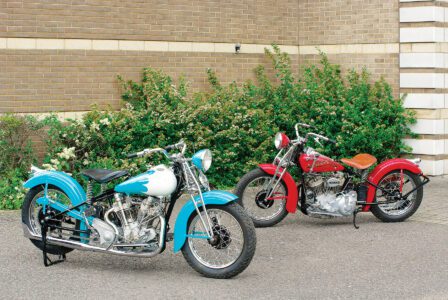1937 Crocker Small Tank and 1940 Crocker Big Tank
Claimed power: 48hp @ 5,800rpm
Engine: 61ci (986cc) air-cooled OHV 45-degree V-twin, 3.25in x 3.625in bore and stroke, 7:1 compression ratio
Weight (dry): 528lb (240kg)
Fuel capacity: Small Tank, 2.5gal (9.5ltr)/Big Tank, 3.5gal (13.2ltr)
Price then/now: $495 (1937)/$385,000 (2015 Mecum auction)
Few series-production motorcycles ever made have achieved such mythical status as the V-twin Crocker, of which roughly 110 examples are thought to have been built in Los Angeles, California, between 1936 and 1942, each one unique.
The fact that Albert G. Crocker, the creator, was notorious for not numbering his products consecutively not only means nobody is exactly sure how many bikes he ended up making, it also gives a hint of the kind of man he was. Rather than concentrate on paperwork, Al Crocker had a single-minded intent to create the fastest, lightest, most powerful and most sophisticated street motorcycle that money could buy. Unfortunately, it was an ambition that proved incompatible with making a profit.
Forced to compete on price with the much larger Harley-Davidson and Indian companies, Crocker suffered a loss on every machine sold even though every bike was supplied directly to the customer, thus avoiding adding a dealer margin to the already high cost. Manufacture of Crockers was subsidized by the profits of the high-tech machine shop where the Crocker bike factory was housed, and when America entered the war in 1941 after Pearl Harbor, Crocker turned his business over to supporting the war effort, leaving no room to continue building bikes of such uncompromising specification.
Crocker offered a refund to any owner who lost a race to an Indian or Harley, and legend has it he never once had to pay up! It’s believed that 65 or so Crocker motorcycles still survive today, the majority with more rakish-looking styling thanks to the smaller 2.5-gallon cast aluminum fuel tank first used against the later so-called Big Tank version, with room for an extra gallon of gas, just 38 of which were made before Crocker shut up shop.
Order the September/October 2015 issue of Motorcycle Classics to read more about the Crocker Small Tank and Big Tank motorcycles. Contact Customer Service at (800) 880-7567 or contact us by email.











